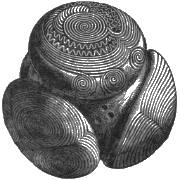Canmore Site 50899: BARNS FARM - DALGETY - BARROW (PREHISTORIC), CIST(S) (PERIOD UNASSIGNED), COFFIN(S) (PERIOD UNASSIGNED), PIT(S) (PERIOD UNASSIGNED), BATTLEAXE, UNIDENTIFIED POTTERY (NEOLITHIC)
Description
| Site Name | BARNS FARM |
|---|---|
| Other Name(s) | BARNS FARM, DALGETY |
| Site Number | NT18SE 8 |
| Broad Class | UNASSIGNED, ARMOUR AND WEAPONS, RELIGIOUS RITUAL AND FUNERARY, UNASSIGNED (OBJECT) |
| Site Type(s) | BARROW (PREHISTORIC), CIST(S) (PERIOD UNASSIGNED), COFFIN(S) (PERIOD UNASSIGNED), PIT(S) (PERIOD UNASSIGNED), BATTLEAXE, UNIDENTIFIED POTTERY (NEOLITHIC) |
| NGR | NT 1780 8417 |
| NGR accuracy | NGR given to the nearest 10m |
| Local Authority | FIFE |
| Parish | DALGETY |
| Record created | 1988-05-03 |
| Last updated | 2000-07-20 |
Archaeology Notes
NT18SE 8 1780 8417 and 1588 8366.
NT 1780 8417 (OS surveyor {JLD} 2 March 1973) A number of Early Bronze Age burials were excavated in the spring of 1973 by the Dept of Archaeology, Edinburgh University, for the DoE. The burials, on a small hill-top, had been covered by a round barrow about 1.0m high which was removed unwittingly by the farmer in the previous year, ploughing in 1973 then revealing a cist.
Buckner (J C R Buckner 1881) mentions the finding of a tumulus here in 1840, and this site is clearly the same one in which "human remains" and "several earthen vessels" were discovered previously.
The 1973 excavations revealed six short cists, three earth graves with wooden coffins two hearths and thirteen miscellaneous pits.
Cist 1, which was luted with clay and had a floor cobbled with white pebbles, contained a contracted inhumation, lying on part of an animal hide, accompanied by a food vessel; also the substantial remains of a lightly cremated body, tucked into an angle of the slabs.
Cist 2, previously disturbed, contained a perforated whetstone, a stone chisel and a flint fabricator.
Cist 3, also previously disturbed, contained two disc-scrapers.
Cist 4, which had a floor cobbled with white pebbles, like cist 1, contained a crouched inhumation, wearing a single string necklace of 211 shale beads, accompanied by a degenerate beaker and two broken jet pendants.
Cist 5, previously disturbed, contained two jet spacer beads.
Cist 6, a "double-decker"contained cremated remains, the upper cremation accompanied by a copper awl.
Grave 1 originally contained a wooden coffin in which was a flexed inhumation, also three concentrations of cremated bone, a food vessel and a battle axe (Roe's type A).
Grave 2, which also had originally held a wooden coffin, contained a flexed inhumation, with a food vessel and a large sack of cremated bones.
Grave 3 was almost ploughed away; traces of the wooden coffin, fragments of cremated bone, a copper dagger, a plano-convex flint knife and a "slug" knife were found.
The pits varied in size, shape and contents. One group (not shown on the T Watkins 1973 plan) contained dark grey soil and one or two small sherds of hard-fired, smooth, presumptively Neolithic pottery. One of the hearths produced a rim of the same fabric. Pits two, three and thirteen contained carbonised nutshells and teeth, evidently from buried heads which had been separated from their bodies. Another pit was
packed with sea-shells, while a food vessel sherd was found in yet another pit, on top of which was a considerable fireplace.
The finds were placed in the National Museum of Antiquities of Scotland (NMAS). Cist 3 was removed and reconstructed experimentally in the grounds of Dalgety Bay Primary School, otherwise the constructions on the site have been entirely removed and the area returned for cultivation.
Site surveyed at 1:2500 (while excavation was in progress). (OS surveyor JLD)
T Watkins 1973; J C R Buckner 1881; F E S Roe 1966; T Watkins 1973;
T Watkins 1974; T Watkins 1983; NMAS 1973-4.
The site is now under cultivation. The reconstructed cist is at NT 1588 8366.
Visited by OS(DWR) 6 March 1974.
The battle-axe from grave 1 is held in the Royal Museum of Scotland under accession number NMS EQ 916. It is of Early form, and has been petrologically identified as chlorite amphibolite.
T H Mck Clough and W A Cummins 1988.
The excavation archive from Barns Farm has been catalogued. It consists of manuscripts, photographic material and drawings.
Historic Scotland Archive Project.
Identifiers and Links to Other Records
Would you like to help find more links?
| Identifier / External Link | Linked Record | Status | Comment |
|---|---|---|---|
| Canmore Site Number (legacy): NT18SE 8 | No linked record | ||
| NMS Primary Reference: 387589 | X.EQ 911 - Necklace / bead | Definite | # beads is off by 1, but I don't think there were lots of 210 bead necklaces found at this site |
| NMS Primary Reference: 387594 | X.EQ 916 - Battle axe | Definite | Acc no match, all data match |
| NMS Primary Reference: 387595 | X.EQ 917 - Bead | Possible | acc no series falls in this dig, although no bone bead is listed. |
| NMS Primary Reference: 387596 | X.EQ 918 - Pottery / food vessel | Possible | acc no series matches this dig; several food vessels are listed with no description |
This area is visible only to logged in users.
